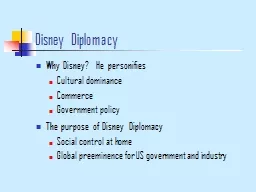

Why Disney He personifies Cultural dominance Commerce Government policy The purpose of Disney Diplomacy Social control at home Global preeminence for US government and industry Good Neighbors ID: 265688
Download Presentation The PPT/PDF document "Disney Diplomacy" is the property of its rightful owner. Permission is granted to download and print the materials on this web site for personal, non-commercial use only, and to display it on your personal computer provided you do not modify the materials and that you retain all copyright notices contained in the materials. By downloading content from our website, you accept the terms of this agreement.
Slide1
Disney Diplomacy
Why Disney? He personifies
Cultural dominance
Commerce
Government policy
The purpose of Disney Diplomacy
Social control at home
Global preeminence for US government and industrySlide2
Good Neighbors
Office of Cultural Relations
Nelson Rockefeller, Coordinator of Commercial and Cultural Relations
Counters German propaganda presence in South America
Argentina and Brazil major battlegrounds
Disney is instructed to make films positive about American achievements, but avoiding “anything which might indeed cause laughter
at
us, instead of
with
us.”Slide3
What did he forget to consider?
Cultural differences between the US and the South American countries
Differences between countries in South America
That South American countries were politically independent
They were not synonymous with the European conquerors whose languages they still spoke, and they might reject European culture in favor of their own traditional cultureSlide4
The government assumed . . .
. . . that Walt Disney, ‘a benign, entertaining, and educational presence,’ could, as a representative of the US, “tour a foreign culture, come to understand it in just a short time, film it, and then bring it back home with him, all with the blessing and thanks of the culture he had visited.” (Smoodin, p. 141)Slide5
OOPS
“I tried to find a way of fixing it (
Goofy Gaucho
), but I found all my efforts so hopeless that I told them I didn’t see any way at all; such was the conglomeration of errors.”
--Florencio Molina Campos Slide6
Doomed to Fail: Why?
Conflict between:
understanding the culture and the need to sell these cartoons to American audiences
The ideas of multimillionaire businessmen and the revolutionary governments of many South American countries
The potential benevolence of a “good neighbor” and the need to maintain cultural and economic dominance over less developed countries
The need to counter Nazi propaganda and the racism inherent in US culture in this periodSlide7
Meanwhile, back at the ranch
The films fail to establish any real dominance in South America
Disney still considered a “great man” by the US government, but conflicts exist:
FBI files
HUAC cooperation
The New Spirit
Interest in promoting the FBI, but increasing impatience at their attempts to censor his workSlide8
The New Spirit
Who found it an excellent use of taxpayers’ money?
Who didn’t?
Why is this significant?
What does it reveal about class and race assumptions in the US at the time?
Would the government even consider making a propaganda film directed primarily at the upper classes? If so, would it be a cartoon?
What do the contemporary responses to the cartoon reveal about the public, as opposed to the media, response to Walt Disney?